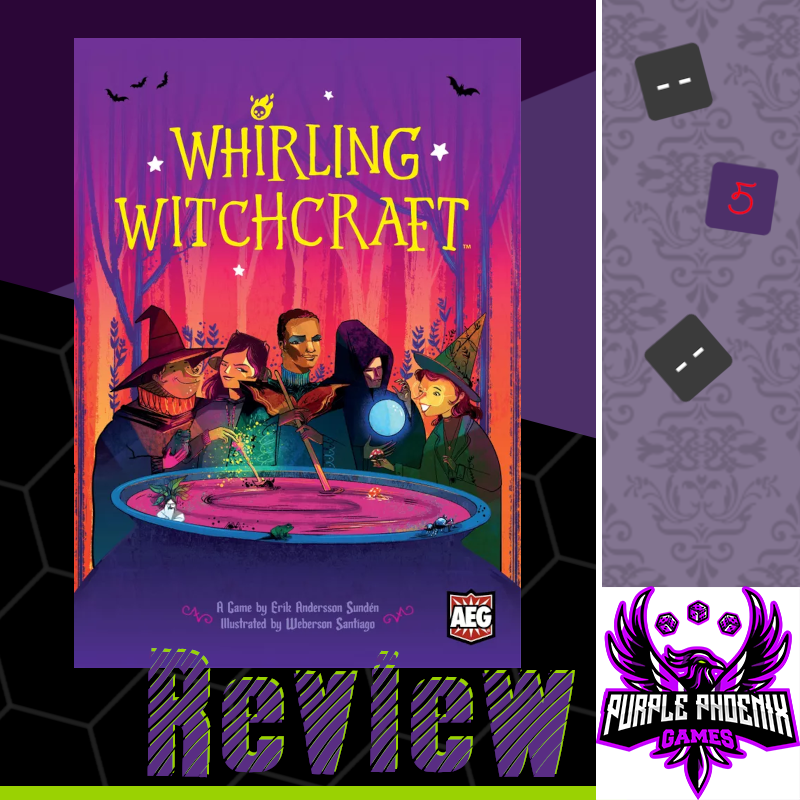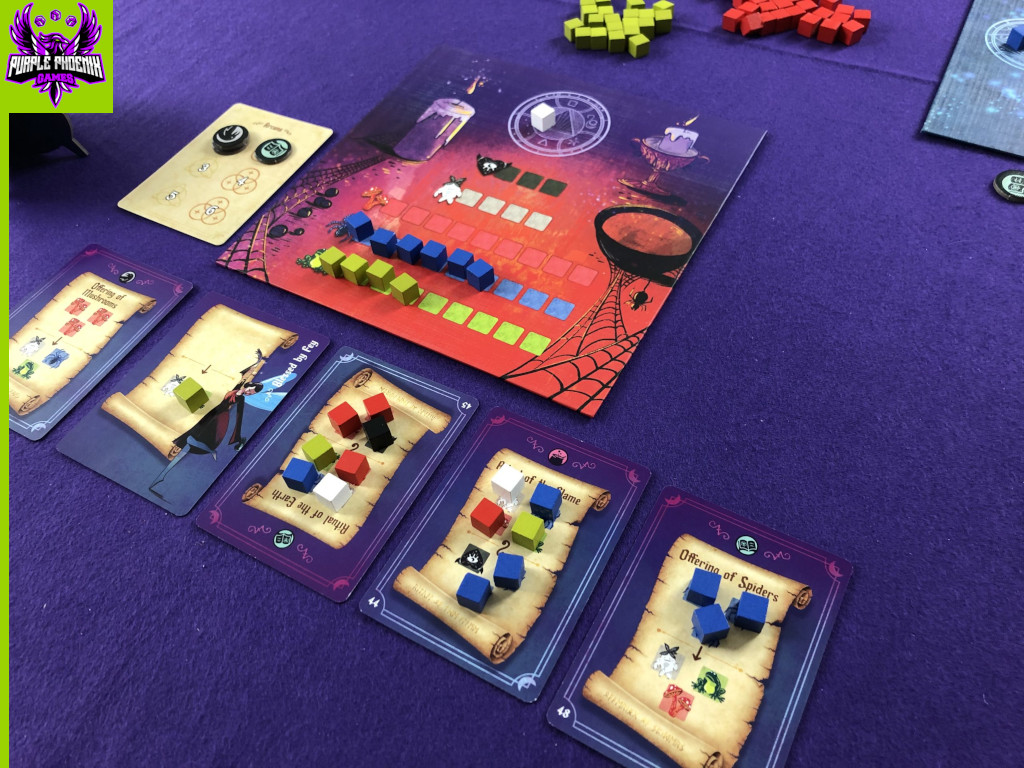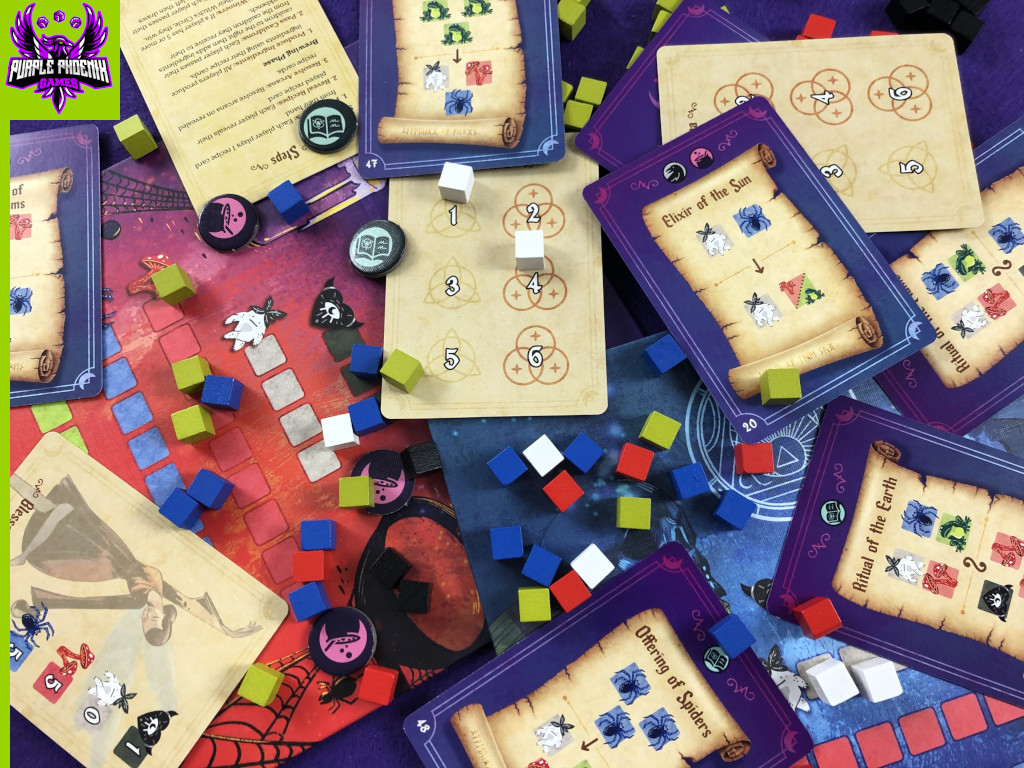
What is the thing that first draws you into a game? Is it talk of the gameplay and mechanics? Maybe you’ve had a good experience with the designer? Or perhaps the artwork is what catches your eye? For me, I’ve gotta say it’s not only the artwork, but the components as well. Obviously, we’re no strangers to board games, so scrolling through our feeds we see countless pictures of cards, boards, meeples, etc. It’s when a game has an interesting new component that it really pops out to me. Enter Whirling Witchcraft and its 3D cardboard cauldrons! It certainly got my attention, but does the game itself deserve a place on my shelves? Spoiler – it does, but keep reading to find out why!
| Whirling Witchcraft (2021) | AEG |
| 2-5 players | 15-30 minutes |
| Ages 14+ | BGG Weight – 2.00 / 5 |
Whirling Witchcraft is a game of simultaneous action selection and variable powers in which players take on the roles of witches creating various ingredients to be used in future potions. The neighboring witches are always on the lookout for new recipes, so of course you’ll share those secrets and even some ingredients with them!…….BUT these ingredients can be volatile, and having too many on your workbench could cause an explosion! Which witch is sly enough to not only manage their ingredients wisely, but also overflow opponents with extra ingredients?
Disclaimer: We were provided with a copy of this game for the purposes of this review. This is a finalized retail copy of the game, and what is described and pictured below is what you will get when you purchase this game. -L
To setup for a game, each player receives a player board, cauldron, and Arcana tracker with corresponding tokens. Players are randomly dealt 2 Personality Cards, and choose one to use for the game. Personality Cards offer unique powers or recipes for use during the game. All recipe cards are shuffled, and 4 cards are dealt to each player. Players receive a number of starting ingredients (cubes) to their workbench (player board), as stated on their Personality card, and the remaining ingredients go into a general supply. Choose a starting player and the game is ready to begin! Pictured below is the setup for a 3-player game.
This game is played over a series of rounds, and the turns in each round are performed simultaneously. Each round is broken down into two phases: the Study Phase and the Brewing Phase. The first step of the Study Phase is to Play recipes. Players look at the 4 recipe cards in hand and select one to play this round. Cards are placed face-down below the player boards. The next step, Reveal recipes, is pretty straightforward – all players reveal their chosen recipe and add it to their other recipes already in play. The final step of this phase is to resolve Arcana. Certain recipe cards have Arcana icons on the top that are collected when the recipe is played. Arcana comes in three different types (Book, Potion, and Raven), and is tracked on your Arcana tracker. When you have reached a certain amount of Arcana, you have the opportunity to trigger a special effect for the current round. For example, triggering the Raven Arcana allows you to immediately remove up to 2 ingredients from your workbench. Arcana can play into your strategy, so keep an eye on which recipes offer certain types of Arcana! Players check to see if any Arcana has been triggered, and perform the effects if they so choose, and the round then continues to the next phase.
The second phase of the round, the Brewing Phase, is broken down into 4 steps: Produce ingredients, Pass cauldrons, Check for winners, and Pass recipe cards. The Produce ingredients step is performed by all players simultaneously. Players will choose which recipe cards they have in play to be used this round. To use a recipe, you place ingredients (cubes) from your workbench on the ‘input’ spaces of the recipe card – all input spaces on a recipe card must be filled for the recipe to be completed. When you complete a recipe, take the corresponding ingredients shown on the ‘output’ spaces of that recipe card from the general supply. Players can decide how many/few of their recipe cards to be used each round (one, a few, or all of them), and each recipe card can only be used once per round. When all players are finished using their recipe cards, the ingredients are distributed. Ingredients from the ‘input’ spaces of a recipe go back to the general supply, and ingredients left on the ‘output’ spaces go into your cauldron.
This leads us to the next step – Pass cauldrons. All players will pass their cauldron (and the ingredients on it) to the player on their right. The ingredients from your new cauldron are now added to your workbench. Each type of ingredient has a finite number of spaces on your workbench, though. If these new ingredients cause you to completely fill up a row, any excess ingredients of that type are given back to the player who passed you the cauldron. Any ingredients you get back from an opponent go at the top of your player board, into your Witch’s Circle. When all players have resolved their new ingredients, the next step is to check for winners. If any player has 5 or more ingredients in their Witch’s Circle, they are declared the winner and the game ends! If nobody has at least 5 ingredients in their Witch’s Circle, players will pass their hand of remaining recipe cards to the player on their left, draw back up to 4 cards, and a new round begins. The game continues in this fashion until a player has at least 5 ingredients in their Witch’s Circle by the end of the round.

As you can tell from my intro, as well as the rating graphic, I really love this game. I came into it expecting something light, cutesy, and fun, and what I got was so much more than that. Yes, the components (more on that later) and artwork are colorful and eye-catching, but the gameplay is what really surprised me. For a game that literally only has 2 mechanics listed on BGG (simultaneous action selection and variable player powers), the amount of strategy in this game blew me away. Is it the most strategic game I’ve ever played? No. But it was one that kept me engaged and thinking the whole time. There are 3 major elements that you have to consider: recipes, ingredients, and your opponents. For recipe cards, you have to strategize which recipe to add to your tableau, as well as which recipes to use each round. You are allowed to use as many recipes in a round as you wish, so which ones are the best use of your resources? The next element: ingredients. Aside from strategizing about your recipe cards, you have to figure out how to best manage your ingredients. Which recipes offer the output you want? Which ones eat up large numbers of ingredients? These are all things you have to be considering during the Brewing Phase. And finally, you have to keep an eye on your opponents. You ultimately win by causing your neighbor to have an ‘overflow’ of ingredients – so which recipes can produce ingredients that they don’t need more of? Everyone can see each others’ player boards, which gives you a little insight into perhaps which recipe cards you want to activate this round. Add the fact that pretty much all of this is happening simultaneously?! That just is another layer to the strategy you need for this game! Even just describing this gameplay and strategic implications has me psyched to play again! There is much more to Whirling Witchcraft than meets the eye, and that makes it an awesome game to me.
Ok, so the part we’ve all be waiting for – components! The player boards, cards, and Arcana tokens are all great quality, and vibrant in color. The artwork itself is a unique style that really catches the eye and fits the theme extremely well. The iconography/color-coded ingredients are clear to differentiate, and help streamline the gameplay. The ingredient cubes are your standard wooden cubes, and they are nice and sturdy for their small size. The 3D cauldrons are sooooo cool! Are they necessary to the gameplay? Wellllll not entirely – you could easily just use a simple cardboard circle on which to place ingredients. BUT they make the game feel more immersive, exciting, and fun to play! AEG could have as easily not gone with the 3D idea, but the inclusion of this unique component helps elevate the engagement and gameplay to me. Having physical 3D cauldrons adds so much to the overall table presence of this game, and it makes it feel like you’re playing a deluxe/upgraded game. Add in the fact that the box is made to house the assembled cauldrons, so you don’t have to be continually assembling/disassembling them every time you play. Great forethought and execution! So all in all, excellent production quality overall!

If you’re in the market for a game with ‘simple’ mechanics but elevated strategy, I highly recommend Whirling Witchcraft. This game truly is a gem, and it plays relatively quickly for a ‘heavier’ game. I’ll be the first to admit that I was drawn to this game by the components, but the stellar gameplay is what makes me keep playing it. Purple Phoenix Games gives this one a whirling 5 / 6. Check it out, you won’t be disappointed!

